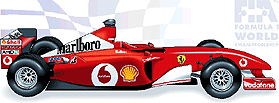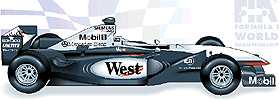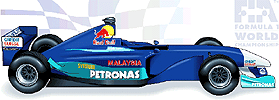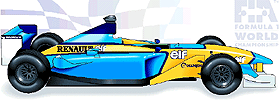
Atlas F1 Magazine Writer
Will Ferrari win their fourth Constructors' Championship in a row, or will McLaren be able to stop the Italian team's momentum? Have Williams showed their real potential during pre-season testing? Who will be the best of the rest this year, and how will newcomers Toyota fare? Richards Barnes previews the 2002 field
That left the anticipation of Toyota's long-delayed debut Grand Prix appearance and the Benetton-to-Renault transition as the main focus of off-season interest. With the limited and minor technical regulation changes implemented for the 2002 season, most teams were happy to tweak existing design philosophies in pursuit of the Holy Grail - lighter weight, lower centre of gravity and improved aerodynamics.
Evolution rather than revolution has been the watchword, and the Melbourne grid will contain few surprises, either in design or form. For almost twenty years, the sport has been dominated by McLaren, Williams and Ferrari, and most seasons come down to a direct clash between the top two teams of this power triumvirate.
That won't change in 2002, although there are promising signs that the spoils will be divided more evenly than ever before, including the 2001 season. The remaining teams will be content to set their sights temporarily on the coveted fourth place in the Constructors' Championship, to wrest the title of 'best of the rest' away from last season's surprise winners, Sauber.
The Teams
SCUDERIA FERRARI
Stability and continuity are the keys. The brains trust of team boss Jean Todt, designer Rory Byrne, technical director Ross Brawn and star driver Michael Schumacher are entering their sixth season together. And, apart from the ritual warnings to each other not to get complacent, they've had a busy off-season. Rory Byrne is upbeat about the new F2002, claiming that it could well be the best F1 car ever produced by Maranello.
With major tweaks to virtually all components, and the incorporation of the 051 engine and new lightweight gearbox, the F2002 could set a new benchmark in F1 dominance. It could also fall apart at the seams, a disaster that would violate Ferrari's 'reliability first' ethic.
The Scuderia have earned their recent Championships largely through building an early-season points lead while their rivals sorted out teething problems. The evolutionary nature of this year's designs has given Ferrari a plan B, of running the F2001 at Melbourne. The year-old design is virtually guaranteed to get them to the finish, which could be enough to again snatch an early Championship lead.
Chief rival McLaren's defection to Michelin has also left Ferrari as the only top team on Bridgestone tyres, allowing them to forge an even closer relationship with the Japanese tyre giant. Overall, Ferrari are looking more solid than ever. Even Rubens Barrichello's dark rumblings about challenging Schumacher for the WDC have a warm ring of familiarity, and a sense that all is going according to Ferrari's ultra-professional and best-laid plans.
MCLAREN MERCEDES
Compared to the stability and continuity of their main rivals Ferrari and Williams, McLaren enter the 2002 season with question marks aplenty. In a calculated risk, McLaren opted to switch tyre camps to Michelin before rivals Ferrari did, and before Williams become too entrenched as 'the Michelin team'. The strategy worked well for McLaren with Bridgestone in 1998, and Dennis will be hoping for a repeat performance. Uncertainty over how the Michelins would work with the McLaren chassis was a major factor influencing Adrian Newey's design but, if the testing times are valid, the MP4/17 will be a strong competitor right out the box.
The driver pairing poses the greatest variable in McLaren's 2002 equation. It's uncertain whether the loss of long-time teammate Hakkinen will work to David Coulthard's benefit or disadvantage. The one certainty is that he will once again enjoy competitive machinery, as well as the team support that he often claimed was lacking during the Hakkinen era. Any points added by standout sophomore talent Kimi Raikkonen will be viewed as a bonus towards achieving McLaren's annual goal - winning the Constructors' Championship.
BMW WILLIAMSF1
Fortunately, they're not fooling anybody. Williams epitomise the 'race to win' ethic, both in their philosophy and their results. When team owner Sir Frank Williams embarks on a new partnership with a major engine manufacturer, it's not a case of 'if' Williams will win, but rather 'when'. He did it with Honda in the latter half of the 80's, with Renault again in the early 90's, and there's no doubting his intentions to complete the hat-trick with current engine partner BMW.
All the pieces are in place. In 2001, both BMW and Michelin produced beyond expectations, and rookie Colombian Juan Pablo Montoya showed constant improvement throughout the season, to the point where he was rattling the normally phlegmatic Ralf Schumacher's cage with regularity during the last quarter of the season.
The core elements of the team's long-standing success, owner Sir Frank Williams and technical director Patrick Head, are as together, as sharp and as controversial as ever. Combined with the most explosive driver pairing in F1, the potential is unlimited. Even in an era of unprecedented major manufacturer participation in the sport, it would be highly out of character for Williams to launch a Championship drive with a new engine partner, only to falter at the final hurdle. Despite the low-key expectations and reservations, Sir Frank Williams knows it, Patrick Head knows it, and any long-time fan of F1 knows it.
SAUBER-PETRONAS
At the same time, Sauber are realistic enough to know that they won't provide more than the occasional challenge to the dominance of the Big Three. Nevertheless they'll be expecting that the C21, along with the continued reliability and competitiveness of the Petronas/Ferrari engines, will at the very least maintain, and perhaps even consolidate, their current status as 'best of the rest'.
Peter Sauber has continued the trend of giving opportunities to emerging young talents rather than journeyman veterans, and seems to have found another talent in ex-Formula Renault and F3000 Euro series driver Felipe Massa. If the 20-year-old can reproduce the form shown by Kimi Raikkonen last year, Sauber will be well-set to repeat their best-ever fourth place finish in the Constructors' Championship. Even with the gaggle of works teams snapping at their gearboxes...
JORDAN HONDA
Eddie Jordan must be pining for the halcyon days of 1999. Even with a jaded Damon Hill underperforming in one car, he still had German Heinz-Harald Frentzen in the Championship hunt right up until the final couple of races. If that represented the summit of Jordan's success, the downslope has been both steep and remorseless. Miserable gearbox reliability, the loss of technical director Mike Gascoyne to Benetton, and the unceremonious and unpopular dumping of Frentzen have all taken the lustre off Jordan's 'fun' image.
The Honda engines, which were hoped to be the final piece of the puzzle in Jordan's drive to winning glory, have also failed to emulate the spectacular results that they produced with Williams and McLaren in the late 80s. Instead, the engine deal has pitched Jordan into a private and fierce Championship battle with fellow Honda-powered BAR.
The re-signing of Italian Giancarlo Fisichella, who raced for Jordan alongside Ralf Schumacher back in 1997, is perhaps symbolic of a return to the team's original 'fun-loving but serious contender' image. The recruitment of technical director Eghbal Hamidy from Arrows in 2001, followed by the return of Gary Anderson as Director of Race and Test Engineering, has given Jordan a timeous boost of expertise and experience.
Although the EJ12 has yet to be launched, the car has been tested with underwhelming results. On the plus side, Fisichella is positive about the EJ12's handling and performance potential. A further bonus is the expected title sponsorship deal with DHL, to offset the reduced Benson and Hedges sponsorship prior to the outright banning of tobacco sponsorship in 2006. Still, Jordan have a mountain to climb in 2002 if they are to regain their former status of 'best of the rest' occasional GP winners.
BAR HONDA
The hype of those early years has been tempered by consistent disappointment, and the team has adopted a more low-key and realistic approach to their 2002 prospects. Engineering Director Malcolm Oastler is cautiously optimistic about his BAR-Honda-004 design, and the launch visuals back up his assertion that it's an evolutionary design that builds on the lessons of the past three seasons.
Without a radically new chassis concept, BAR appear to be placing their improvement hopes squarely on the shoulders of Honda and the new RA002E engine. Former WDC Jacques Villeneuve, the centrepiece and focus of the team since day one, has adopted a 'let's wait and see' attitude. Testing has been alternatively promising and disappointing, and hasn't provided any definitive answers regarding the overall pace of the car.
Richards, Oastler and Villeneuve will be setting their minimum sights on beating Jordan and attaining some form of measurable improvement over last season's results. If another BAR campaign peters out mid-season, in order to concentrate development on next year's car, it's unlikely that Villeneuve's patience will hold out.
RENAULT
The French manufacturer aims to change that with the transformation of the Benetton-Renault team into a fully-fledged Renault operation. During the final stanza of the 2001 season, the benefits of Renault engineering and innovation came to the fore. A dismally disappointing season was turned around almost overnight, as the Benettons of Giancarlo Fisichella and Jenson Button suddenly started to leap-frog cars that had been faster all season.
That momentum has carried over into the 2002 pre-season testing, and Mike Gascoyne's R202 design, with its unique RS22 V10 engine, already appears to have a lock on at least fifth in the Championship. Not that fifth, fourth or even third will be seen as anything other than a tolerable starting point for Renault's longer-term ambitions.
In the last twenty years, Flavio Briatore is the only team principal outside the Big Three to have won both Championships, and he'll be expected to repeat the achievement - this time without Michael Schumacher. And that is Briatore's most obvious stumbling block. Jenson Button appears to be coming out of his 2001 slump and Jarno Trulli is arguably the finest qualifier in the field. If either has the capability to take on Michael Schumacher, now is their opportunity to show it.
JAGUAR RACING
There is some positive news for Jaguar as well though. Even though Cosworth have not produced a new engine for the 2002 season, the CR3 engine used in 2001 has undergone development, and now features the much-desired lower centre of gravity than the 2001 version of the engine. Two new sponsor partnerships, with EDS software and DuPont Performance Coatings, have brought welcome relief in the current climate of financial instability.
Jaguar Racing boss Niki Lauda believes that, after the early setbacks, the R3 Jaguar will turn out to be better than last year's R2. He adds: "We don't have to win the title this year, we just have to do better than last year." Given that last year's Jaguar scored a paltry nine points (four of those in the high-attrition Monaco GP), it seems like a modest and realistic ambition.
ORANGE ARROWS
Like Jordan, Arrows have delayed the launch of the new A23, citing driver lineup uncertainty as the cause. Driver contracts have become an expensive concern for Tom Walkinshaw's Leafield-based team, which owes Pedro Diniz compensation of more than $700,000 and will face further legal action from Jos Verstappen, the Dutch driver axed in favour of Heinz-Harald Frentzen.
With the driver controversies occupying the news, the A23's first public testing sessions were late and low-key, with the lone contracted driver Enrique Bernoldi conducting the secret shakedowns and first tests. Progress has been positive though and, in Frentzen's hands, the car has performed well above expectations, ending up third fastest behind the Renaults at Barcelona and in the middle of the pack at Valencia.
Preliminary indications are that the A23, the work of Chief Designer Sergio Rinland and ex-Ferrari Aerodynamicist Nicolo Petrucci, could surprise a few of the more highly-rated midfield runners.
EUROPEAN MINARDI
Minardi are to F1 what the West Indies are to cricket - every fan's second-favourite team because of the joie de vivre that they bring to the sport. Yet not even the minnows of modern F1 are immune to the head-hunting that characterises the business, and lost prized technical director Gustav Brunner to Toyota in May 2001. Brunner's replacement as head of the Minardi design team, aerodynamicist Loic Bigois, used extensive wind-tunnel testing time in Italy and England to help produce the PS02, Minardi's 2002 entrant.
Powered by the new Asiatech AT02 V10 engine, the Minardi team are pleased with the car's progress during testing, and feel that they can rectify the blank scoresheet of the last two seasons and once again score Championship points in 2002. With the PS02 still to be officially launched, testing times indicate that Paul Stoddart's Italian outfit will take up their perennial position towards the back of the grid. It's equally certain that, once the racing gets underway, F1 fans all around the world will again be willing the 'other' Italian team on towards their goal of a minor points placing.
PANASONIC TOYOTA
After nearly a year in waiting, Toyota are ready to enter the fray with their F1 campaign. Unlike BAR of 1999, the Japanese manufacturer is under no illusions about the enormity of the task, and the team have chosen to downplay their aims and prospects in their debut season. As one of the very few teams to manufacture the entire car including engine, Toyota faces an even steeper learning curve than other recent entrants to the sport. Yet they have set about the task with a sense of realism and professionalism.
There is no lack of racing experience in the team. Toyota Motorsport President Ove Andersson and Chief Designer Gustav Brunner have decades of top-level experience, and the Toyota F1 project has also head-hunted technical experts from a range of other teams and racing formulae. Even with the accumulated expertise and experience, there will be no substitute for the lessons learnt racing on the track, and Andersson concedes that progressing up the grid will be a long process.
Toyota's initial test car, which was run at several F1 circuits around the world during 2001, proved to be a lot slower than its F1 competitors. The Gustav Brunner-designed 2002 debut entrant, the TF102, is an entirely new albeit conventional design, which is hoped to be more competitive than the test car. January testing times from Barcelona indicate that Toyota's 'five seconds slower than the field' image of 2001 is history, but also that they are unlikely to give the front-runners any sleepless nights. At least, not in 2002.
During the winter off-season, F1 fans looked forward to the prospect of a 12-team grid for the new season in 2002. The financial woes of Alain Prost's outfit served as a grim reminder of the exorbitant resources necessary to compete in modern Formula One, and the French court's decision to shut down Prost Grand Prix has reverted the field back to the 11-team standard that has prevailed since the 1998 season.
 It's always easier to chase a title than defend one. Ferrari embark on their 2002 campaign defending three consecutive Constructors' and two consecutive Drivers' Championships, in the full knowledge that merely maintaining the status quo will be an epic challenge. However, they've done everything possible to stack the deck in their favour.
It's always easier to chase a title than defend one. Ferrari embark on their 2002 campaign defending three consecutive Constructors' and two consecutive Drivers' Championships, in the full knowledge that merely maintaining the status quo will be an epic challenge. However, they've done everything possible to stack the deck in their favour.
 After a year of infuriating start-line stalls and the near-defection of Adrian Newey to Jaguar, topped off by Mika Hakkinen's decision to take a sabbatical, McLaren could have been expected to treat the 2002 season as a rebuilding campaign of low expectations. McLaren team principal Ron Dennis and Mercedes motorsport boss Norbert Haug clearly had other ideas, and McLaren answered their detractors with a series of storming testing sessions that have placed them right back in the Championship frame. Testing times are often misleading, but McLaren's pedigree as winners is not.
After a year of infuriating start-line stalls and the near-defection of Adrian Newey to Jaguar, topped off by Mika Hakkinen's decision to take a sabbatical, McLaren could have been expected to treat the 2002 season as a rebuilding campaign of low expectations. McLaren team principal Ron Dennis and Mercedes motorsport boss Norbert Haug clearly had other ideas, and McLaren answered their detractors with a series of storming testing sessions that have placed them right back in the Championship frame. Testing times are often misleading, but McLaren's pedigree as winners is not.
 After a period of almost unprecedented mediocrity in their trophy-rich history, Williams have turned the downplaying of expectations into an artform. The launch and initial testing of the team's FW24 challenger followed this trend faithfully. Chief Designer Gavin Fisher lamented the diminishing returns of an evolutionary design principle, and BMW's Gerhard Berger has already bemoaned the FW24's lack of outright pace. Even if Williams owned the front row at Melbourne and lapped the field en route to a 1-2 finish, they'd probably still claim that 'we're not yet ready to mount a serious Championship challenge.'
After a period of almost unprecedented mediocrity in their trophy-rich history, Williams have turned the downplaying of expectations into an artform. The launch and initial testing of the team's FW24 challenger followed this trend faithfully. Chief Designer Gavin Fisher lamented the diminishing returns of an evolutionary design principle, and BMW's Gerhard Berger has already bemoaned the FW24's lack of outright pace. Even if Williams owned the front row at Melbourne and lapped the field en route to a 1-2 finish, they'd probably still claim that 'we're not yet ready to mount a serious Championship challenge.'
 Having finally discovered the key to season-long pace during 2001, Peter Sauber's outfit are back and raring to go. Like Ferrari, Sauber have attempted to push the envelope further than most other teams with the 2002 car. Some of the changes implemented in Willy Rampf's C21 design were mandated purely out of need - the lowering of the sidepods to aid cooling of the Petronas-badged Ferrari engine, and the lowering of the cockpit sides to allow diminutive Nick Heidfeld a decent view of the world around him. But the new car is also a bold design that reflects the new-found optimism and success of the Swiss-based team.
Having finally discovered the key to season-long pace during 2001, Peter Sauber's outfit are back and raring to go. Like Ferrari, Sauber have attempted to push the envelope further than most other teams with the 2002 car. Some of the changes implemented in Willy Rampf's C21 design were mandated purely out of need - the lowering of the sidepods to aid cooling of the Petronas-badged Ferrari engine, and the lowering of the cockpit sides to allow diminutive Nick Heidfeld a decent view of the world around him. But the new car is also a bold design that reflects the new-found optimism and success of the Swiss-based team.
 Former team boss Craig Pollock's departure before Christmas capped what has been a three-year baptism of fire for the BAR team. Prodrive Chairman and ex-Benetton boss David Richards has taken over as Team Principal of BAR, and will hope to deliver the sort of results that constituted 'realistic expectations' at the time of the team's 1999 F1 debut.
Former team boss Craig Pollock's departure before Christmas capped what has been a three-year baptism of fire for the BAR team. Prodrive Chairman and ex-Benetton boss David Richards has taken over as Team Principal of BAR, and will hope to deliver the sort of results that constituted 'realistic expectations' at the time of the team's 1999 F1 debut.
 The Renault racing tradition is one of pride, innovation and success. From winning the first GP they ever entered to supplying engines for 11 Championship-winning teams, Renault have almost succeeded at will whenever the fancy took them. There is just one glaring omission on their racing CV - no Renault car has ever won the Constructors' Championship. The closest they came was with the innovative early turbo cars in the mid-80's, when future legend Alain Prost took the 'yellow teapot' to the brink of Championship glory.
The Renault racing tradition is one of pride, innovation and success. From winning the first GP they ever entered to supplying engines for 11 Championship-winning teams, Renault have almost succeeded at will whenever the fancy took them. There is just one glaring omission on their racing CV - no Renault car has ever won the Constructors' Championship. The closest they came was with the innovative early turbo cars in the mid-80's, when future legend Alain Prost took the 'yellow teapot' to the brink of Championship glory.
 What a difference six months makes. Late in 2001, Jaguar boss Bobby Rahal looked to have scored a major coup in luring primo designer Adrian Newey away from McLaren. Six months later, not only is Rahal gone, but so is technical director Steve Nichols. New Jaguar boss Niki Lauda is left with a late replacement technical director in Guenther Steiner, a flawed front-wing design, and season prospects that look daunting at best.
What a difference six months makes. Late in 2001, Jaguar boss Bobby Rahal looked to have scored a major coup in luring primo designer Adrian Newey away from McLaren. Six months later, not only is Rahal gone, but so is technical director Steve Nichols. New Jaguar boss Niki Lauda is left with a late replacement technical director in Guenther Steiner, a flawed front-wing design, and season prospects that look daunting at best.
 Irrespective of how they fare in Melbourne, Toyota's debut GP performance is sure to be the talking point of the race. Any new F1 team arouses close interest, particularly so when it's a major big-budget manufacturer with a proven pedigree in other forms of motorsport.
Irrespective of how they fare in Melbourne, Toyota's debut GP performance is sure to be the talking point of the race. Any new F1 team arouses close interest, particularly so when it's a major big-budget manufacturer with a proven pedigree in other forms of motorsport.
Please Contact Us for permission to republish this or any other material from Atlas F1.
|
Volume 8, Issue 8
2002 Season Preview
2002 Drivers Preview
2002 Teams Preview
2002 Technical Preview
Men and Motors
Articles
The FIA's Court of Appeal: Part IV
Off-Season Strokes
Columns
Elsewhere in Racing
The Weekly Grapevine
> Homepage |